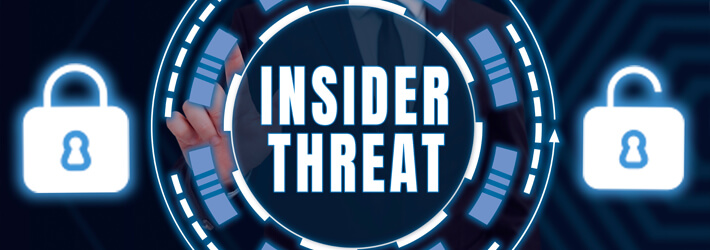Last Updated on September 12, 2023 by Satyendra

Insider threats pose a significant risk to organizations today, potentially resulting in significant damage to their security, reputation, and operations. Merely reacting to these threats after an incident occurs is no longer sufficient.
Instead, companies must adopt a more proactive approach by implementing robust security protocols, monitoring employee behavior, and establishing early warning systems to identify and mitigate potential insider threats before they cause any harm.
Developing and implementing a comprehensive insider threat prevention program demonstrates a commitment to safeguarding an organization’s intellectual property, confidential information, and critical assets, aligning with regulatory requirements, such as GDPR and industry-specific compliance standards.
Why Take a Proactive Approach to Insider Threat Prevention?
Organizations must adopt a proactive approach to insider threats because they pose a significant and often underestimated risk to their data, operations, and reputation. Insider threats occur when current or former employees, contractors, or business partners misuse their access and privileges to intentionally or unintentionally harm the organization. Here’s why a proactive stance is crucial:
- Preventing Data Breaches: Insider threats can lead to data breaches, which can be devastating in terms of financial losses and damage to the organization’s reputation. Proactive measures, such as continuous monitoring and user behavior analytics, can help identify suspicious activities before they escalate into breaches.
- Protecting Intellectual Property: Intellectual property theft by insiders can result in the loss of proprietary information, research, or trade secrets. A proactive approach can safeguard these assets by restricting access and monitoring unusual data transfers or downloads.
- Mitigating Sabotage: Some insiders may intentionally sabotage an organization’s systems, networks, or operations. By proactively monitoring and controlling access, organizations can reduce the risk of such attacks and their potentially catastrophic consequences.
- Compliance and Legal Consequences: Regulatory requirements and legal obligations demand organizations take reasonable steps to protect sensitive data. Being proactive not only helps in meeting these requirements but also demonstrates a commitment to compliance, reducing legal liabilities.
- Preserving Trust: Insider incidents can erode trust among employees, customers, and partners. A proactive approach can demonstrate a commitment to security and privacy, helping to maintain trust and credibility.
- Early Detection: Proactive measures enable the early detection of insider threats, giving organizations the opportunity to intervene before significant harm occurs. This might involve counseling or training for employees displaying risky behavior.
- Cultural Awareness: A proactive approach promotes a culture of security awareness within the organization. Employees become more vigilant and accountable, making it harder for malicious insiders to operate undetected.
- Cost-Effective: It is often more cost-effective to prevent insider threats than to respond to a breach aftermath. Proactive security measures can save an organization significant financial resources.
What a Proactive Approach to Insider Threat Prevention Looks Like
Below are some of the most notable ways to prevent insider threats:
Create a culture of security:Regular security awareness training programs are vital in educating employees about cybersecurity and their role in preventing security incidents. The program should include educating employees about different types of attacks such as phishing, malware, and social engineering. Secondly, the program should provide guidelines on how to create strong and unique passwords, ensure secure remote access, and use encrypted communication channels. Training should emphasize the significance of regular software updates, the dangers of sharing sensitive information on social media, and the proper procedures for reporting potential security incidents. Lastly, the program should incorporate interactive elements, such as simulations and quizzes, to reinforce understanding and gauge knowledge retention.
Enforce the principle of least privilege: Limiting access to sensitive information and systems to only those who absolutely require it for their role is of utmost importance in safeguarding against insider threats. Granting access to a select group of individuals ensures that the right people have access to valuable and confidential data, while minimizing the risk of unauthorized access or misuse. In addition to mitigating breaches, limiting access also simplifies monitoring and audit processes, making it easier to detect any suspicious activities and maintain appropriate levels of accountability within the organization.
Monitor user behavior: User and Entity Behavior Analytics (UEBA) tools use advanced machine learning techniques to detect patterns and anomalies in employee and device activity within an organization. By analyzing vast amounts of data from various sources, such as login information, application usage, and network traffic, UEBA tools can establish a baseline of normal behavior for individuals and devices. Any deviation from this baseline is flagged as suspicious activity, triggering alerts for further investigation. This proactive approach enables organizations to detect and respond to potential threats at an early stage, minimizing the risk of security incidents and allowing for prompt intervention.
Encourage reporting of suspicious activity: Establishing clear channels for employees to report unusual behavior without fear of retribution is crucial in fostering a culture that encourages the reporting of suspicious activity. Such channels create a safe environment where employees can express concerns without facing any negative consequences. This open communication enables organizations to identify and address potential risks before they escalate into major issues. By removing the fear of retribution, employees are more likely to share valuable insights.
Conduct regular audits and assessments: Regular audits and assessments play a crucial role in maintaining a secure network. By conducting periodic reviews of user access rights and system configurations, potential areas of risk can be identified and mitigated effectively. These audits aid in ensuring that security controls are properly implemented and functioning as intended, preventing unauthorized access, data breaches, and other potential security threats. Regular assessments also contribute to compliance with industry regulations and best practices, enhancing overall system integrity and reducing vulnerabilities.
How Lepide Helps Prevent Insider Threats
The Lepide Data Security Platform continuously monitors various parameters, such as user actions, data access, file transfers, geolocation, and network activity, to identify suspicious behavior that may indicate insider threats. By analyzing these behavioral patterns in the context of the user’s role, responsibilities, and privileges, we can differentiate legitimate user activities from potentially malicious insider actions. For instance, an alert may be triggered if an employee who does not typically handle certain data suddenly accesses it. To establish a baseline of normal behavior, our solution monitors patterns for each user and entity within the network. With the help of machine learning algorithms, any deviations from this baseline can be flagged as potential insider threats. Real-time alerts are then generated and sent to the relevant parties for further investigation. Risk scores are assigned to each user based on their activities to prioritize insider threat investigations and focus resources on high-risk users exhibiting suspicious traits. Our solution may also integrate with other security systems to enforce restrictions, block access, or initiate incident response protocols. Additionally, our solution provides insights into historical user behavior and trends, which can be used to refine security policies, conduct periodic audits, and enhance proactive insider threat prevention measures. By detecting and alerting on potential insider threats in real-time, the Lepide Data Security Platform empowers organizations to proactively prevent insider attacks, reducing the risk of data breaches and other malicious activities.
If you’d like to see how the Lepide Data Security Platform can help with proactive insider threat prevention, schedule a demo with one of our engineers.


